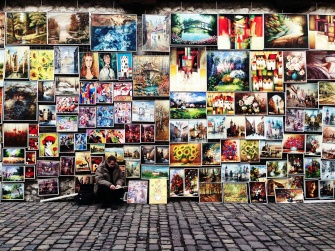By Kristin Peixotto Twitter LinkedIn
If you have skimmed any social media channels lately, you might have noticed the increase in visual content. It is everywhere, including video, infographics, pictures, and more. There is a good reason for this, as from 2015 to 2016 marketers use of visual content increased a whopping 130%!
Why the sudden move to visual?
With so much content on the web, marketers are having to grab audiences’ attention with the help of interactive content. So they are using a ploy that most of us learned in kindergarten: picture books are more interesting than books with text. Okay, stay with me here… If books with pictures can help children who have a limited knowledge and short attention spans, why wouldn’t this work for adults? … And apparently, it does! So much so, that visuals are processed 60,000 times faster than text, according to Adweek.

Has this move to visuals worked?
Yes, and astonishing so
Here are a few stats from Hubspot:
- 51% of all video plays are on mobile devices a growth of 15% 2015 and 203% growth
from 2014 - Infographics are “liked” and shared on social media 3 times more than other types of content
- Tweets with images receive 150% more retweets compared to tweets without
- Facebook posts with images see 2.3 x more engagement than those without
- Snapchat users watch 10 billion videos per day
- Snapchat users share 9,000 photos per second
What types of content tend to have the best response?

Venngage surveyed more than 300 marketers, here are what they reported had the best engagement rates:
- 41.5% infographics
- 25.7% charts and data visualizations
- 20.2% video and presentations
- 7.6% stock photos
- 5% GIFs and Memes
Are there any tools I can use to make my content more visual?
Yes! Here are a few:
- Canva– This is a free tool that helps you make all types of graphics. They provide templates and some free pictures to include.
- Pictochart– This free tool makes creating infographics simple. They also provide templates and some free pictures to include.
- Adobe Spark– This is similar to canva, but is paid. You can create social graphics, web stories, videos, and more. High-quality results.
- Visually– This is a paid tool that will help you create videos, infographics, ebooks, reports & presentations, social graphics, and interactive microsites.
- Tabeau– This is a free tool that helps create data visualizations.
- Plotly– This tool has both a free and paid version. The tool will help you with data visualizations including charts, presentations, and dashboards.
“90% of all information that comes into our brain is visual”




Great response on the diminishing attention spans of society, Kristin!
Couldn’t agree more with the idea that adults are developing the mindsets of children in the sense that they prefer imagery to retain concepts. As attention spans become shorter, companies are inclined to put their visual and digital media departments into overdrive in order for people to recall their products or services. In my personal opinion, infographics are an excellent visual way to relay information to the public. Whether that be a health advisory regarding how to stay healthy during flu season or a ‘Top 10’ list of how to become a successful company, people resonate more with something that they can visually see.
Nice post about the increase in visual content. On a personal level I can attest to the fact that I am more in engaged in social media posts that have GIF’s, memes, videos, or pictures. As a marketer, this is an important tactic in all promotional attempts, but especially with social media posts. In addition to good visual content, posts should have some kind of clever caption to further engagement.